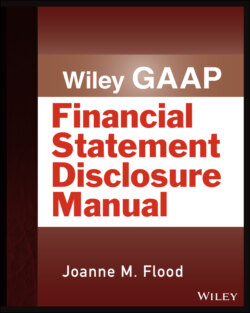Читать книгу Wiley GAAP: Financial Statement Disclosure Manual - Joanne M. Flood - Страница 81
Other Issues Related to Classification of Cash Flows
ОглавлениеAcquisition and Sales of Trading Debt Securities Cash receipts and payments from purchases and sales of securities that are classified in the statement of financial position as trading debt securities in accordance with Topic 320 and equity securities accounted for in accordance with Topic 321 are classified in the statement of cash flows based on the nature and purpose for which the securities were acquired. (ASC 230‐10‐45‐19)
Insurance Proceeds and Payments Proceeds from the settlement of insurance claims are classified based on the nature of each component of the loss. (ASC 230‐10‐45‐21B)
Cash payments for premiums on corporate‐owned life insurance policies (COLI), including bank‐owned life insurance (BOLI), are classified as outflows for investing or operating activities or a combination of investing or operating activities. (ASC 230‐10‐45‐21C)
Distributions Received from Equity Method Investees Upon applying the equity method, the entity must make an accounting policy election regarding the classification of distributions received from equity method investees choosing one of two approaches:
1 The cumulative earnings approach. In this approach, the investor compares the distribution received with its cumulative equity method earnings since inception. Distributions received up to the amount of cumulative earnings are a return on investment classified in operating activities. Excess distributions are considered a return on interest, classified as investing activities.
2 Nature of distribution approach. The entity classifies distributions based on the nature of the investee's activates that generated the distribution. If the information necessary to implement this approach is not available, the investor should use the cumulative earnings approach and report a change in accounting principle.(ASC 230‐10‐45‐21D)
More Than One Class of Cash Flows If a cash receipt or payment has aspects of more than one class of cash flows, entities should apply the guidance in ASC 230 and any other relevant Topic. If there is no specific guidance, classify separately each cash source or use based on the nature of the underlying cash flow. (ASC 230‐10‐45‐22) When a cash receipt or payment has aspects of more than one cash flow category that cannot be separated, it should be in the category that is likely to be the predominant source of cash flows. (ASC 230‐10‐45‐22A)
Discontinued Operations The disclosure requirements relevant to discontinued operations and related cash flows can be found in ASC 205‐20‐50‐5B(c). (ASC 230‐10‐45‐24A)
Noncash Investing and Financing Activities The effects of investing and financing investing or operating activities that do not result in receipts or payments of cash should be reported in a separate schedule immediately following the statement of cash flows or in the notes to the financial statements in narrative or tabular format. (ASC 230‐10‐50‐3) This is to preserve the statement's primary focus on cash flows from operating, investing, and financing activities. Examples of noncash investing and financing activities include:
Converting debt to equity.
Acquiring assets by assuming liabilities, such as buying a building by incurring a mortgage to the seller.
Obtaining a right‐of‐use asset in exchange for a lease liability.
Obtaining an asset by receiving a gift.
Exchanging noncash assets or liabilities for other noncash assets or liabilities.(ASC 230‐10‐50‐4)
If a transaction is part cash and part noncash, only the cash portion is reported in the body of the statement of cash flows. (ASC 230‐10‐50‐5) If the entity has only a few noncash transaction, they may be included on the same page as the statement of cash flows. If not, the transactions may be reported elsewhere in the financial statements with a clear reference to the statement of cash flows. (ASC 230‐10‐50‐6)
Reporting Hedging Transactions The cash flows resulting from derivative instruments that are accounted for as fair value hedges or cash flow hedges may be classified as the same type of cash flows as the hedged items provided that the accounting policy is disclosed. There is an exception for hedges considered to have a financing element at inception. If the derivative instrument used to hedge includes at inception an other‐than‐insignificant financing element, all cash inflows and outflows associated with the derivative instrument are reported by the borrower as cash flows from financing activities. A derivative that at inception includes off‐market terms, or requires up‐front cash payment, or both, often contains a financing element. A derivative instrument is viewed as including a financing element if its contractual terms have been structured to ensure that net payments will be made by one party in the earlier periods of the derivative's term and subsequently returned by the counterparty in the later periods (other than elements that are inherent in at‐the‐money derivative instruments with no prepayments). If for any reason hedge accounting for an instrument is discontinued, then any cash flows subsequent to the date of discontinuance are classified consistent with the nature of the instrument. (ASC 230‐10‐45‐27)
Other Topics with Cash Flow Subtopics Some other Topics in the Codification have Subtopics on cash flows. Those should be reviewed for additional guidance and include:
ASC 830‐230, Foreign Currency Matters
ASC 926‐230, Entertainment—Films
ASC 942‐230, Financial Services—Depository and Lending
ASC 946‐230, Financial Services—Investment Companies
ASC 958‐230, Not‐for‐Profit Entities
ASC 970‐230 Real Estate—General
ASC 978‐230 Real Estate—Time‐Sharing Activities(ASC 230‐10‐05‐03)
